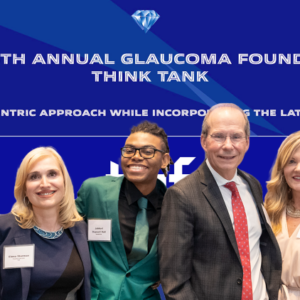May 5, 2023
Why do some individuals develop open-angle glaucoma? Is it related to a person’s genetic makeup, or could it be due to lifestyle? What about environmental issues? Is it a combination of factors, or no reason at all? The reasons why diseases occur are complex, and finding the answers requires a great deal of thought and research. As I delve further into this topic, I will examine factors (myopia, genetics) that might explain why some glaucomas develop. I will also discuss what people can do (meditation, diet, exercise) to reduce the risk of developing glaucoma or the disease worsening. I’ll talk about treatments that go beyond taking medication or having surgery.
The idea is to personalize care, which includes considering lifestyle, social history, and family history when deciding on management. For example, I believe smoking is one factor that influences the occurrence of glaucoma, and yet there is conflicting evidence concerning its impact on glaucoma development.1,2,3 It’s been known that cigarette smoking is related to a host of systemic conditions such as cardiovascular disease, pulmonary disease, and lung cancer4,5,6 as well as ocular conditions (macular degeneration, cataracts, dry eye, diabetic retinopathy).7,8,9,10 But the relationship between smoking and glaucoma is all over the map, with reports of it having a protective effect on glaucoma development perhaps due to neuroprotection.3
More Packs Per Day Increases Odds for Glaucoma
A paper by Law and colleagues, published in 2018, used data from the 2005 and 2008 National Health and Nutrition Examination Survey performed with adults 40 years and older. Controlling for age, gender, ethnicity, income, alcohol consumption, diabetes, and hypertension revealed a relationship between smoking and glaucoma.11 The greater number of packs per day smoked was associated with increasing odds of having glaucoma (OR=1.70, 95% CI=1.08-2.67, P=0.02). This paper included perimetry and optic nerve assessment to confirm cases of glaucoma and strengthen its conclusions.
What is happening as one smokes cigarettes that might make a person susceptible to the development of glaucoma? Is there ischemic or oxidative damage occurring? In a 2022 paper published in the Journal of Glaucoma, Eslani investigated the effects of smoking on optic nerve head capillary density in individuals with open-angle glaucoma (OAG).12 The study included 432 eyes varying from early glaucomas (without field loss) to more severe glaucomatous damage. Age, glaucoma severity, and other confounders were adjusted with each 10-pack years increase in smoking, a reduction in image capillary density surrounding the optic nerve head was seen. The reduction in capillary density may be due to microinfarction and capillary nonperfusion as it is known that cigarette smoking associated with vascular disease occludes the arteriole lumen and constricts the blood vessels. With these papers, a picture forms that those at risk of developing glaucoma, such as those with ocular hypertension who smoke cigarettes, might be more apt to convert to glaucoma.
Smoking Linked to Glaucoma Progression
In a 2022 paper published in the British Journal of Ophthalmology, Nishida and colleagues evaluated whether smoking is associated with glaucoma progression.13 This longitudinal study enrolled individuals who had primary open-angle glaucoma (POAG) and smoked cigarettes. Enrollment also included a group with POAG who did not smoke. Patients needed to have at least three years of follow-up with smoking intensity calculated based upon their pack-years at the time of the baseline OCT. Of the 314 patients enrolled, 121 (39%) had a history of smoking. The study found that greater smoking intensity was associated with faster retinal nerve fiber layer (RNFL) thinning, after adjusting for confounding factors. RNFL thinning was especially fast for those with > eight pack-years with a hockey-stick like effect. While we think about progression being related to higher IOP levels, exfoliative disease, or family history, another consideration may be whether someone ever smoked cigarettes and if so, how much and how long. This could influence management.
Lifestyle Therapy is Key
Glaucoma is a common cause of blindness throughout the world. There are an estimated one billion smokers, or 13.5% of the world’s population, so modifying smoking behavior might be helpful in reducing glaucoma-related blindness. Inquiring about smoking history when managing glaucoma could lead to changes in treatment regimen, whether it is in the intervals seen, medications, or surgery. For years, internists have managed cardiovascular disease with medications as well as lifestyle modifications (diet, exercise, weight loss). When we think about managing glaucoma, clinicians are aware of the medical and surgical options, but a third component is developing — lifestyle therapy. This option includes modifying smoking behavior, and it might turn out to be an important tool.
References
1 Edwards R, Thornton J, Ajit R, Harrison RA, Kelly SP. Cigarette smoking and primary open angle glaucoma: a systematic review. J Glaucoma. 2008; 17(7): 558–566.
2 Klein BE, Klein R, Ritter LL. Relationship of drinking alcohol and smoking to prevalence of open-angle glaucoma. The Beaver Dam Eye Study. Ophthalmology 1993; 100(11): 1609–1613.
3 Kang JH, Pasquale LR, Rosner BA, Willett WC, Eqan KM, Faberowski N et al. Prospective study of cigarette smoking and the risk of primary open-angle glaucoma. Arch Ophhalmol. 2003; 121(12): 1762–1768.
4 Nance R, Delaney J, McEvoy JW, et al. Smoking intensity (pack/day) is a better measure than pack-years or smoking status for modeling cardiovascular disease outcomes. J Clin Epidemiol. 2017;81:111–119.
5 Hedley AJ, Lam TH, McGhee SM, et al. Passive smoking – Secondhand smoke does cause respiratory disease. Br Med J. 2003;327:502–502.
6 Joseph AM, Rothman AJ, Almirall D, et al. Lung Cancer Screening and Smoking Cessation Clinical Trials SCALE (Smoking Cessation within the Context of Lung Cancer Screening) Collaboration. Am J Respir Crit Care Med. 2018; 197:172–182.
7 Moss SE, Klein R, Klein BE. Prevalence of and risk factors for dry eye syndrome. Arch Ophthalmol. 2000; 118(9): 1264–1268.
8 Thornton J, Edwards R, Mitchell P, Harrison RA, Buchan I, Kelly SP. Smoking and age-related macular degeneration: a review of association. Eye 2005; 19(9): 935–944.
9 Kelly SP, Thornton J, Edwards R, Sahu A, Harrison R. Smoking and cataract: review of causal association. J Cataract Refract Surg. 2005; 31(12): 2395–2404.
10 Thornton J, Kelly SP, Harrison RA, Edwards R. Cigarette smoking and thyroid eye disease: a systematic review. Eye 2007; 21(9): 1135–1145.
11 Law SM, Lu X, Tseng V, et al. Cigarette smoking and glaucoma in the United States population. Eye 2018; 32:716-725.
12 Eslani M, Nishida T, Weinreb RN, et al. Effects of smoking on optic nerve head microvasculature in glaucoma. J Glaucoma 2022, 31:710-716.
13 Nishida T, Mahmoudinezhad, G, Weinreb RN, et al. Smoking and progressive retinal nerve fiber layer thinning in glaucoma. Bri J Ophthalmol 2022; 1-8.





